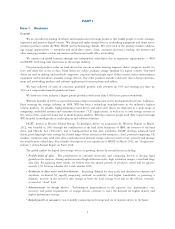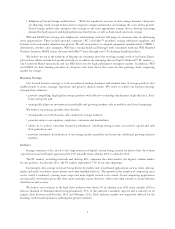Western Digital 2012 Annual Report Download - page 15
Download and view the complete annual report
Please find page 15 of the 2012 Western Digital annual report below. You can navigate through the pages in the report by either clicking on the pages listed below, or by using the keyword search tool below to find specific information within the annual report.‰HGST Touro™ family of storage appliances are designed to keep digital content secure while providing port-
able storage for desktops and notebooks;
‰WD My Book®and WD Elementstm Desktop family of storage appliances are designed to add external
capacity to desktops, notebooks and DVRs and connect to networks to simplify storage for consumers;
‰WD Sentinel™ is a complete network storage solution designed to meet the needs of small-to-medium sized
businesses (“SMBs”);
‰WD TV®media players connect to a user’s television or home theater system and play digital movies, music
and photos from an integrated hard drive, network hard drives, any of our WD®-branded external hard drives,
other USB mass storage devices or content services accessed over the Internet;
‰WD Livewiretm enables consumers to use their existing electrical outlets to extend secure and reliable high-
speed Internet connections throughout the home; and
‰WD My Net™ is a family of wireless home networking products, designed specifically to accelerate movies,
video and gaming, which delivers a premium high-definition entertainment experience. The My Net™ family
debuts WD’s exclusive FasTrack™ technology that instantly detects entertainment traffic on the network and
prioritizes it for gaming consoles, media players, smart TVs, tablets, smart phones, computers and other Wi-Fi
connected devices.
Research and Development
We devote substantial resources to the development of new products and the improvement of existing products.
We focus our engineering efforts on coordinating our product design and manufacturing processes to bring our prod-
ucts to market in a cost-effective and timely manner. Research and development expenses totaled $1.1 billion,
$703 million and $611 million in 2012, 2011 and 2010, respectively. For a discussion of risks related to our
development of new products, see Item 1A of this Annual Report on Form 10-K.
Technology and Product Development
Hard Drives
Hard drives provide non-volatile data storage, which means that the data remains present when power is no
longer applied to the device. The primary measures of hard drive performance include:
‰Acoustics — sound power emitted during hard drive operation, commonly expressed in decibels, and perceived
loudness due to sound pressure, commonly expressed in sones;
‰Data transfer rate — sustained rate of data transfer to and from the disk, commonly expressed in gigabits per
second. One gigabit equals one billion bits;
‰Power consumption — which is the amount of electricity required to operate the drive, measured in watts;
‰Seek time — time needed to position the heads over a selected track on the disk surface, commonly expressed
in milliseconds;
‰Spindle rotation speed — nominal rotation speed of the disks inside the hard drive, commonly expressed in
RPM or latency. Spindle rotation speeds commonly stated as 5,400, 7,200 and 15,000 RPM are sometimes
approximations; and
‰Storage capacity — which is the amount of data that can be stored on the hard drive, commonly expressed in
GB or TB. As defined in the storage industry, one GB equals one billion bytes and one TB equals one trillion
bytes. A byte is a digital character, typically comprised of eight bits. A bit is a binary digit, the smallest unit
of information in a digital system.
Industry-standard interfaces allow the drives to communicate with the host system. The primary interface for
PCs is SATA and the primary interfaces for enterprise systems are SAS, Fibre Channel Arbitrated Loop and SATA.
9
























